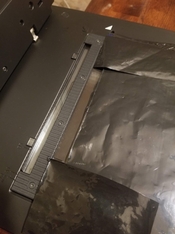jonmon6691
Member
For folks who are wet-mount scanning, or scanning directly on the glass, it's important to mask off the area around the negative to get the maximum dynamic range out of your flatbed scanner.
I came across this issue when trying to scan my transmission density step wedge and got some really bad results, so I tried it again using a discarded photo paper bag to mask around the step wedge. These bags are as close to completely light-proof as you're going to get for anything this easy to cut/manipulate, but thick card stock would probably work as well.



Nearly 2.5 stops of highlights are completely lost to the backlight diffusing around the edge of the negative! And the roll-off starts even earlier. If you're using the negative carrier, these are already blocking all the extraneous light, but the wet-mounting carrier or direct on-glass scanning will suffer unless you provide your own masking.
What's interesting about this result is the implication that low-density areas of the image could cause this effect on nearby high-density areas effectively reducing dynamic range in high contrast scenes. The scanner effectively suffers from "bloom".
I came across this issue when trying to scan my transmission density step wedge and got some really bad results, so I tried it again using a discarded photo paper bag to mask around the step wedge. These bags are as close to completely light-proof as you're going to get for anything this easy to cut/manipulate, but thick card stock would probably work as well.


Nearly 2.5 stops of highlights are completely lost to the backlight diffusing around the edge of the negative! And the roll-off starts even earlier. If you're using the negative carrier, these are already blocking all the extraneous light, but the wet-mounting carrier or direct on-glass scanning will suffer unless you provide your own masking.
What's interesting about this result is the implication that low-density areas of the image could cause this effect on nearby high-density areas effectively reducing dynamic range in high contrast scenes. The scanner effectively suffers from "bloom".





